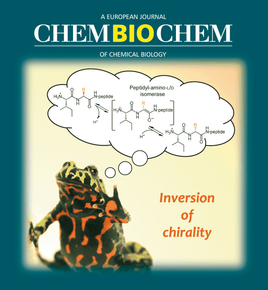Research
MAQC Consortium 2011–2014 (read more)
FDA SEQC, Nature Biotechnology (read more)
Bioinformatics (read more)
FEBS Journal (read more)
Gerontology (read more)
A search for vertebrate peptides containing D-amino acids (FWF P22782)
In multicellular organisms many vital
functions are mediated by peptides. Some of
these peptides contain a D-amino acid in a
well-defined position. To date, in all
vertebrates and several invertebrates the
D-amino acid is the second residue of the
mature peptide whereas it has been found in
other positions in invertebrates. Vertebrate
peptides comprise dermorphins, deltorphins,
and the peptide antibiotics bombinin H from
frog skin, as well as a C-type natriuretic
peptide (CNP) and beta-defensin-like peptide
(DLP) from the venom of male Platypus, a
primitive mammal. In case of the opioid
peptides, the all L-forms are inactive,
whereas subtle differences in activity and
physicochemical properties between the two
diastereomers of bombinin H have been
observed. From skin secretions of Bombinae,
an enzyme has been isolated which catalyses
the posttranslational inversion of the
stereochemistry of the respective L-amino
acids present in the precursor of bombinin
H. This L/D-isomerase acts exclusively on
the second residue. Genes encoding
polypeptides related to the frog skin enzyme
are present in many vertebrates including
man supporting the idea of the existence of
diastereomeric peptides in higher mammals.
 A detailed study of the substrate specificity of the frog isomerase and subsequent data base search has led to the identification of potential substrates, which include hormones, antibacterial peptides etc., for which a D-form could exist as well. Based on this knowledge, we mainly focus on the questions, whether i) the diastereomeric form of a few selected peptides can be detected in animal tissues and thus the presence of the D-residue be directly confirmed, and ii) the biological activity and/or physicochemical properties of the peptides are modulated by the stereoinversion. In particular, the D-amino acid could crucially affect receptor interactions, folding propensities or polypeptide turnover in these pepides and thus have far-ranging consequences on their biological function.
A detailed study of the substrate specificity of the frog isomerase and subsequent data base search has led to the identification of potential substrates, which include hormones, antibacterial peptides etc., for which a D-form could exist as well. Based on this knowledge, we mainly focus on the questions, whether i) the diastereomeric form of a few selected peptides can be detected in animal tissues and thus the presence of the D-residue be directly confirmed, and ii) the biological activity and/or physicochemical properties of the peptides are modulated by the stereoinversion. In particular, the D-amino acid could crucially affect receptor interactions, folding propensities or polypeptide turnover in these pepides and thus have far-ranging consequences on their biological function.
Participants
Alexander Jilek - Projekt Leader
Farghaly Mohammed Farghaly Ali - Pre-Doctoral Fellow
Omair Rauf - Diploma Student
Rasha Ramadan Aly - Technical Assistant
Project-related publications
Gehmayr, V; Mollay, C; Reith, L; Müller, N; Jilek, A. Tight binding of transition-state analogues to a peptidyl-aminoacyl-L/D-isomerase from frog skin. Chembiochem. 2011;12:1996-2000;
Jilek, A; Mollay, C; Lohner, K; Kreil, G. Substrate specificity of a peptidyl-aminoacyl-L/D-isomerase from frog skin. Amino Acids. 2011 Mar 22.
Gössler-Schöfberger, R; Hesser, G; Muik, M; Wechselberger, C; Jilek, A. An orphan dermaseptin from frog skin reversibly assembles to amyloid-like aggregates in a pH-dependent fashion. FEBS J. 2009;276:5849-59.
Zangger, K; Gössler, R; Khatai, L; Lohner, K; Jilek, A. Structures of the glycine-rich diastereomeric peptides bombinin H2 and H4. Toxicon. 2008;52:246-54.
Jilek, A; Mollay, C; Tippelt, C; Grassi, J; Mignogna, G; Müllegger, J; Sander, V; Fehrer, C; Barra, D; Kreil, G. Biosynthesis of a D-amino acid in peptide linkage by an enzyme from frog skin secretions. Proc Natl Acad Sci U S A. 2005;102:4235-9.
Invited Reviews:
Jilek, A and Kreil, G. D-Amino Acids in Animal Peptides. 2008; 139:1-5.


